Kawasaki Ninja ZX-12R
The Kawasaki Ninja ZX-12R is a motorcycle in the Ninja sport bike series made by Kawasaki from 2000 through 2006. The 1,199 cc (73.2 cu in) inline-four engine produced 178 hp (133 kW) at low speed, and increased to 190 hp (140 kW) at high speed due to its ram-air intake,[8][9][10] making it the most powerful production motorcycle up to 2006 and the release of the ZX-14.[6][11] It was a contender to be the fastest production motorcycle, and played a role in bringing to a truce the escalating competition to build an ever-faster motorcycle. Its top speed was electronically limited to 186 mph (300 km/h), tying it with the Suzuki Hayabusa and Kawasaki Ninja ZX-14 as the fastest production motorcycle on the market, after the 303–312 km/h (188–194 mph) 1999 Hayabusa was replaced with a speed-limited version as part of a gentlemen's agreement between motorcycle manufacturers that lasted until the 298–311 km/h (185.4–193.24 mph) 2007 MV Agusta F4 R 312.[3][12][13][14]
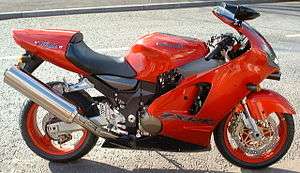 2000 Kawasaki Ninja ZX-12R | |
| Manufacturer | Kawasaki Motorcycle & Engine Company |
|---|---|
| Parent company | Kawasaki Heavy Industries |
| Production | 2000–2006 |
| Successor | Kawasaki Ninja ZX-14 |
| Class | Sportbike |
| Engine | 1,199 cc (73.2 cu in) four-stroke, liquid-cooled, 16-valve DOHC, inline-four |
| Bore / stroke | 83.0 mm × 55.4 mm (3.27 in × 2.18 in) |
| Compression ratio | 12.2:1 |
| Top speed | 301 km/h (187 mph)[1] |
| Power | 133.1 kW (178.5 hp) @ 9,500 rpm (claimed)[2] 120.2–121.3 kW (161.2–162.7 hp) (rear wheel)[3][4] |
| Torque | 137 N⋅m (101 lb⋅ft) @ 7,500 rpm (claimed)[2] 123.7 N⋅m (91.2 lb⋅ft) (rear wheel)[3] |
| Transmission | Wet clutch, 6-speed, chain |
| Frame type | Aluminum monocoque |
| Suspension | Front: 43 mm KYB , Inverted telescopic fork, with adjustable preload, 12-way rebound and 12-way compression damping (4.72 in.) wheel travel Rear: Bottom-Link with gas-charged shock: piggy-back reservoir, adjustable spring preload, 18-way rebound and 20-way compression (5.51 in.) wheel travel |
| Brakes | Front: Dual semi-floating 320 mm (13 in) discs with dual 6-piston tokico calipers Rear: Single 230 mm (9.1 in) disc with opposed 2-piston caliper |
| Tires | Dunlop Sportmax II D207 Front: 120/70ZR17 Rear: 200/50ZR17 |
| Rake, trail | 23.5°, 93 mm (3.66 in) |
| Wheelbase | 1,440 mm (56.69 in) |
| Dimensions | L: 2,080 mm (81.89 in) W: 720 mm (28.5 in) H: 1,185 mm (46.65 in) |
| Seat height | 810 mm (31.9 in) |
| Weight | 210 kg (463 lb)[2][5][6] (dry) 247 kg (545 lb)[3][7] (wet) |
| Fuel capacity | 20 l; 4.4 imp gal (5.3 US gal) |
| Oil capacity | 2,800 ml (2.96 US qt) oil & filter change 3,600 ml (3.8 US qt) completely dry |
| Fuel consumption | 7.3 L/100 km; 38.6 mpg‑imp (32.1 mpg‑US)[3] |
| Turning radius | 3.0 m (9.8 ft) |
| Related | Kawasaki Ninja ZX-6R Kawasaki Ninja ZX-7R Kawasaki Ninja ZX-9R Kawasaki Ninja ZX-10R |
Model designation
Usually 1,200 cc Kawasaki sport bike were called ZZ-R1200 in some markets and ZX-12R in others, but the ZX-12R only went by one name. The 2002–2005 Kawasaki ZZ-R1200 touring motorcycle did use this scheme, going by either ZZ-R1200 or ZX-12C.[15] The ZX-12R's R designation followed the race-replica Kawasaki ZX-6R, ZX-7R, ZX-9R, ZX-10R.
Top speed limited by agreement
From the first year of production ZX-12R, in the 2000 model year, its top speed was restricted by a motorcycle manufacturer gentlemen's agreement that was started in late 1999.[12][3][16][17] This was due to a voluntary gentlemen's agreement that included BMW Motorrad and the Japanese manufacturers, amid fears of government regulation of motorcycle speeds mainly in Europe.[12] Prior to the agreement, with rumors of going 200-mph[18] Kawasaki had planned a world press event to launch their answer to Suzuki's Hayabusa, but the event was abruptly cancelled, and instead the ZX-12R with a revised engine control unit that limited speed to about 300 km/h was released with no fanfare or comment by Kawasaki.[19]
Performance
At its introduction the ZX-12R was Kawasaki's flagship sport bike and a competitor to the Suzuki Hayabusa. Its handling and braking matched the power of the engine resulting in a motorcycle that was docile at low speeds and very easy to handle in heavy traffic, but had strong acceleration. The 1,199 cc (73.2 cu in) displacement engine generated 161.2 hp (120.2 kW) at the rear wheel.[3] Cycle World tested the ZX-12R's 0 to 97 km/h (0 to 60 mph) acceleration at 2.59 seconds.[20] They found an electronically-limited top speed of 187 mph (301 km/h), a 97 to 0 km/h (60 to 0 mph) braking distance of 36 m (118 ft), and fuel economy of 32.1 mpg‑US (7.3 L/100 km; 38.6 mpg‑imp).[7] They tested the 0 to 1⁄4 mi (0.00 to 0.40 km) time at 10.04 seconds, reaching 231.39 km/h (143.78 mph).[7] The 1/4 mile result Motorcyclist reported was 9.87 seconds at 235.43 km/h (146.29 mph), [4] and Sport Rider found 9.95 seconds at 232.39 km/h (144.40 mph).[21]
Monocoque aluminum frame
While most sport bikes use an aluminum perimeter frame, the ZX-12R uses a unique monocoque aluminum frame. Described by Cycle World in 2000 as a "monocoque backbone...a single large diameter beam" and "Fabricated from a combination of castings and sheet-metal stampings", this was the first use of this type of frame on a mass-produced production motorcycle.[22][23] This design surpasses the level of chassis strength and stiffness associated with conventional aluminum perimeter frames. Its intention was also to make the bike narrower, and thereby more aerodynamic. The design saves space by housing the battery and incorporating an efficient airbox and a cartridge-type air filter that slides into the frame. It was fuel injected with four Mikuni 46 mm throttle bodies and was Kawasaki's first fuel-injected sport bike since the 1981–1985 GPZ1100.[24]
Model history
The 2002 model was updated with 140 changes.[4] While some of those changes made the bike easier to launch, with a heavier crankshaft and a reshaped flywheel and fuel mapping changes. It had 1.3 hp (0.97 kW) less than the 2000 and 2001 models' 162.7 hp (121.3 kW).[4] It had a revised suspension with stiffer front fork springs and a softer rear shock spring. The front fender had cosmetic changes, and panels were added to the inner fairing below the instruments and bars. The centrally-located ram-air intake scoop protruding from the fairing that takes advantage of the higher front air pressure was revised. This intake is integrated into a wider and shorter front cowling from Kawasaki Aerospace Company division, lowering the drag coefficient by one point from 33 to 32.[25][11] The last update was in 2004, with the addition of radial brakes and more fuel injection changes. The ZX-12R was discontinued in 2006, and was followed by the 2006ZX-14 (ZZR1400) which had a similar monocoque frame.
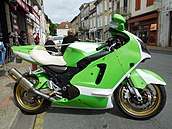
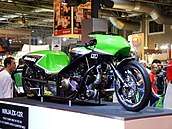
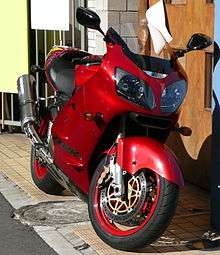
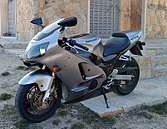
| Wikimedia Commons has media related to Kawasaki Ninja ZX-12R. |
References
- Citations for top speed:
- "Performance Index '10" (PDF), Motorcycle Consumer News, Bowtie Magazines, 2010, archived from the original (PDF) on 2010-02-15, retrieved 2011-02-14
- Burns, John (April 2, 2012), "Fifty Years of "Do You Have Any Idea How Fast You Were Going?" A brief history of Ludicrous Speed", Cycle World, archived from the original on April 7, 2012, retrieved November 5, 2012CS1 maint: unfit url (link)
- Brown, Roland (2006), The Ultimate History of Fast Motorcycles, Bath, UK: Parragon, pp. 284–284, ISBN 1-4054-7303-7
- Hoyer, Mark (June 2000), "ZX-12R; Kawasaki's Ultimate Weapon makes a politically correct debut", Cycle World, pp. 36–42
- Kimber, David (2004). "Motorcycle-Mania!". Gareth Stevens. Retrieved September 4, 2016.
- "Nikko ZX-12R G-Pack over 3". Cycle World. January 2003. Retrieved September 4, 2016.
- Sievert, Terri (2002). "The World's Fastest Superbikes". Capstone Press. Retrieved September 4, 2016.
- Dowds, Alan (2007). "High-speed Superbikes". Gareth Stevens. Retrieved September 4, 2016.
- Kawasaki Ninja ZX-12R Service Manual. Section 1, page 5
- "Performance Index '10" (PDF), Motorcycle Consumer News, Bowtie Magazines, 2010, archived from the original (PDF) on 2010-02-15, retrieved 2011-02-14
- "Godzilla gets civilized". Motorcyclist. February 24, 2009. Retrieved February 25, 2016.
- "ZX-12R Nada Guides". Nada guides. Retrieved February 3, 2016.
- "First Ride: 2002 Kawasaki ZX-12R". Motorcycle .com. March 17, 2002. Retrieved February 28, 2016.
- Hoyer, Mark (June 2000), "ZX-12R; Kawasaki's Ultimate Weapon makes a politically correct debut", Cycle World, pp. 36–42
- Doran, Jon (August 1995). "Ram Air: Whats It Worth". Sport Rider. Retrieved February 3, 2016.
- "Ram Air: Test". Sport Rider. October 1999. Retrieved February 3, 2016.
- "Ram Air Test: Part Deux". Sport Rider. December 1999. Retrieved February 3, 2016.
- "Road Tests: Used". Visor Down. August 17, 2008. Retrieved February 3, 2016.
- Burns, John (April 2, 2012), "Fifty Years of "Do You Have Any Idea How Fast You Were Going?" A brief history of Ludicrous Speed", Cycle World, archived from the original on April 7, 2012, retrieved November 5, 2012CS1 maint: unfit url (link)
- Corbetta, Luigi (2010), Legendary motorcycles, Translated by Marco Visenti, VMB Publishers, pp. 280–283, ISBN 978-88-540-1538-8 As reported in Motociclismo magazine (Italy)
- Cernicky, Mark (May 9, 2007). "First Ride: MV Agusta F4 R312". Cycle World. Retrieved May 5, 2016.
- "Kawasaki ZX-6 and ZZR600 - Best Used Bikes". Cycle World. September 3, 2010. Retrieved May 31, 2017.
- Brown, Roland (2006), The Ultimate History of Fast Motorcycles, Bath, UK: Parragon, pp. 284–284, ISBN 1-4054-7303-7
- "Nikko ZX-12R G-Pack over 3". Cycle World. January 2003. Retrieved September 4, 2016.
- Hutchison, Ken (November 8, 2002). "2002 Kawasaki ZX-12R". Motorcycle USA.com. Retrieved February 28, 2017.
- Edwards, Dave (June 2000), "Speed Bleed; The convoluted case of the ZX-12's missing mph", Cycle World, p. 41
- Hoyer, Mark (June 2002). "THRUST! Life, liberty and the high-speed pursuit of happiness". Cycle World. Archived from the original on 2019-08-06. Retrieved September 4, 2016.
- "Motorcycle Performance Numbers". Sport Rider. Archived from the original on February 12, 2008. Retrieved February 25, 2016.CS1 maint: unfit url (link)
- "Kawasaki Technology". Kawasaki Heavy Industries Motorcycle & Engine. Archived from the original on January 12, 2017. Retrieved December 18, 2016.
- Anderson, Steve (January 2000). "MEAN GREENIES". Cycle World. p. 34. Retrieved August 12, 2017.
- Trevitt, Andrew (October 2001). "Big Dogs: The Contender". Sport Rider. Archived from the original on November 5, 2015. Retrieved February 3, 2016.
- Edge, Dirck (March 5, 2002). "2002 Kawasaki ZX-12R: MD Ride Review – Part Two". Motorcycle Daily.com. Retrieved February 29, 2016.
| Records | ||
|---|---|---|
| Preceded by Suzuki Hayabusa |
Fastest production motorcycle 2000-20061 |
Succeeded by Kawasaki Ninja ZX-14 |
| Notes and references | ||
| 1. Fastest in production during its lifetime, but not record holder | ||